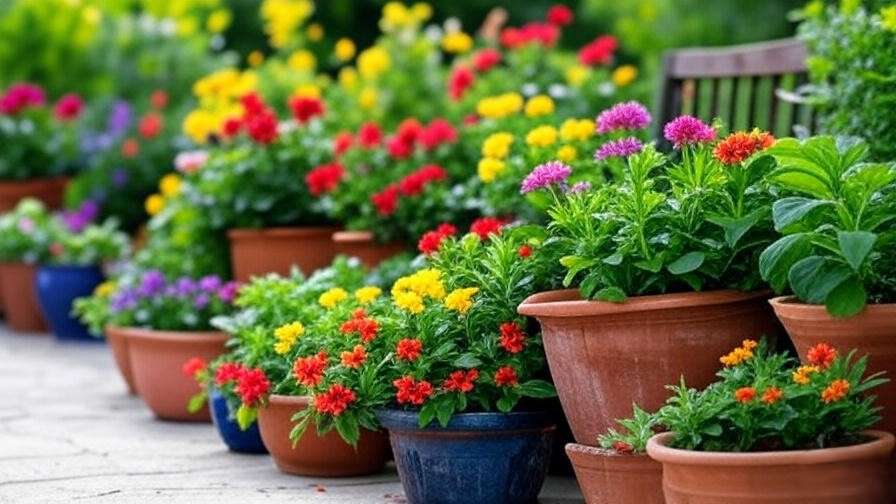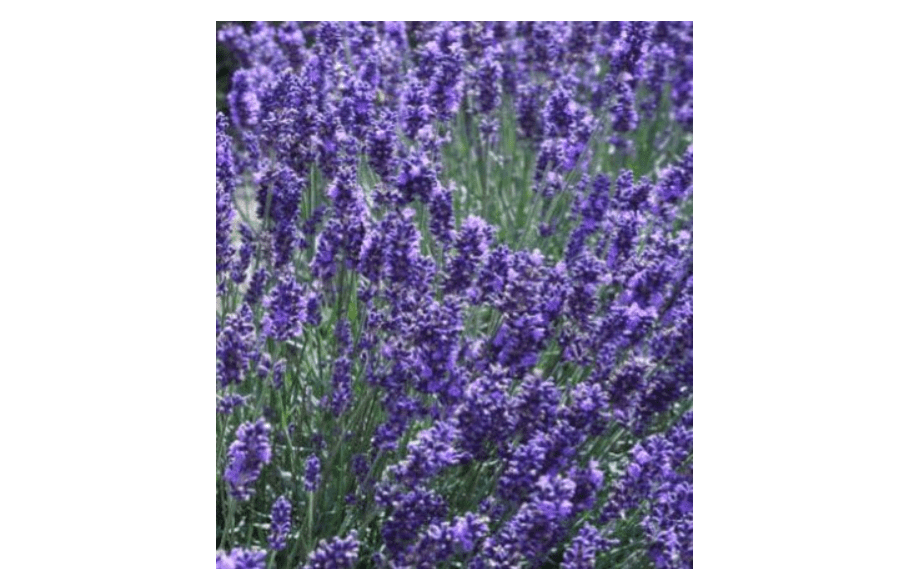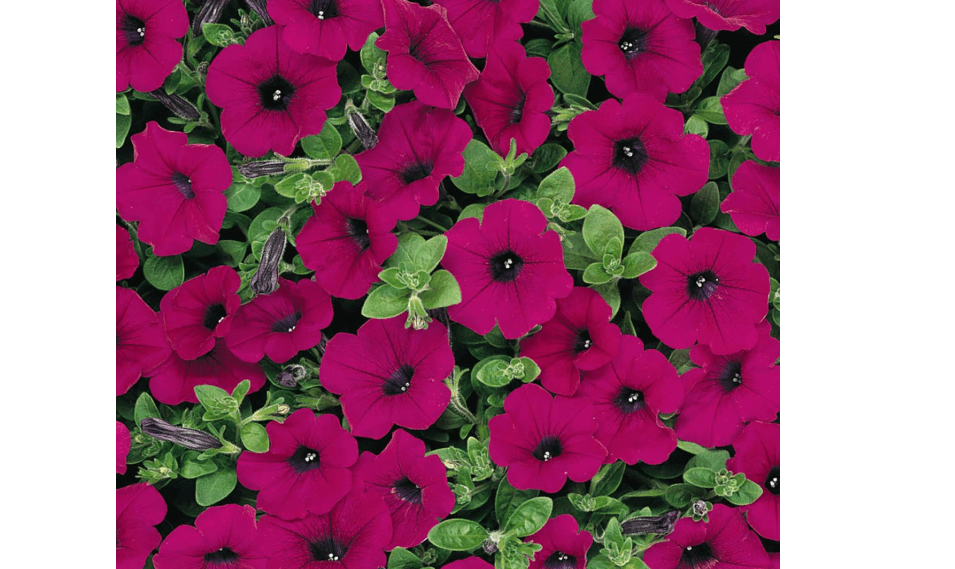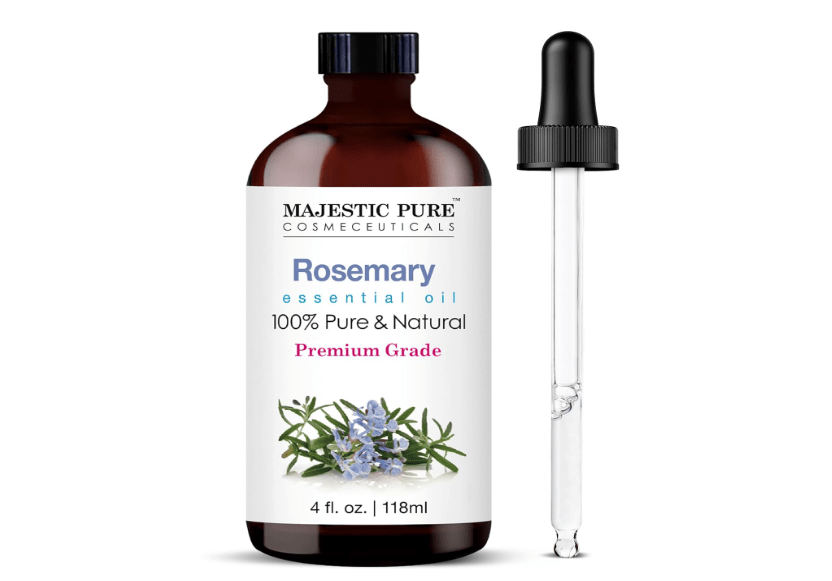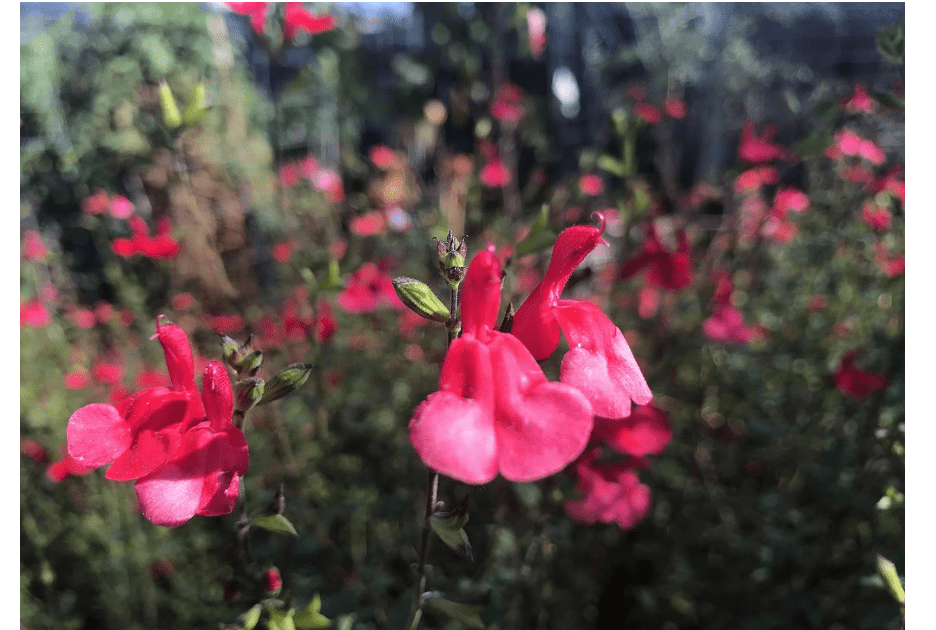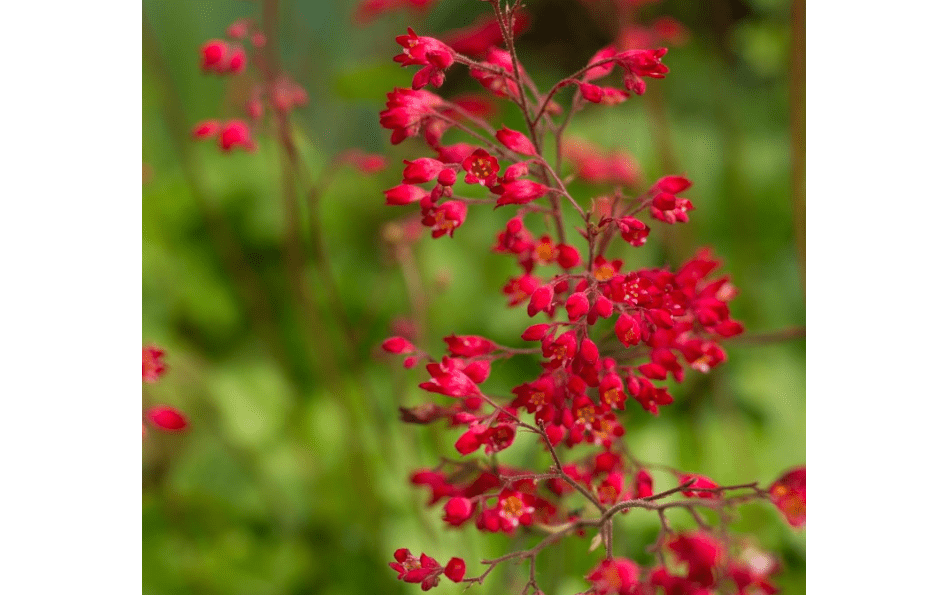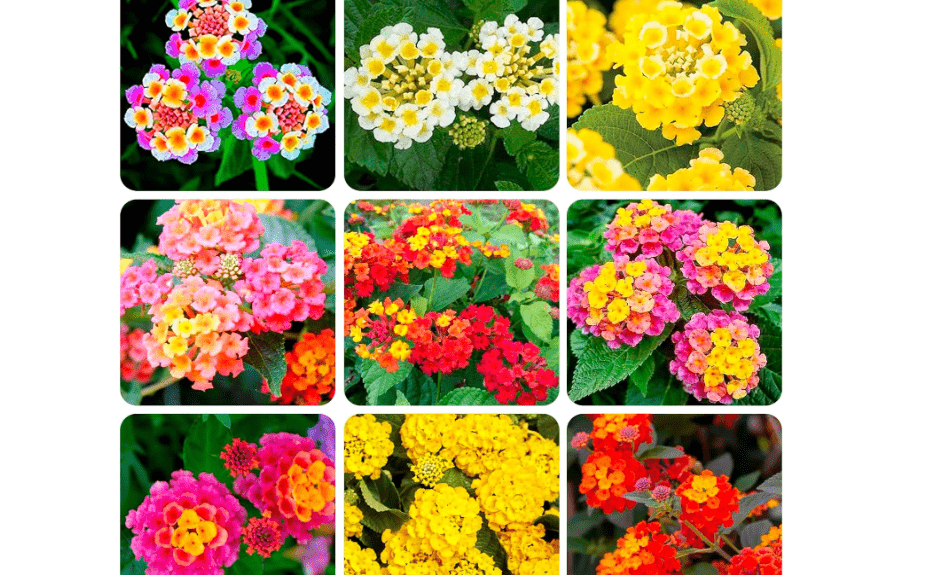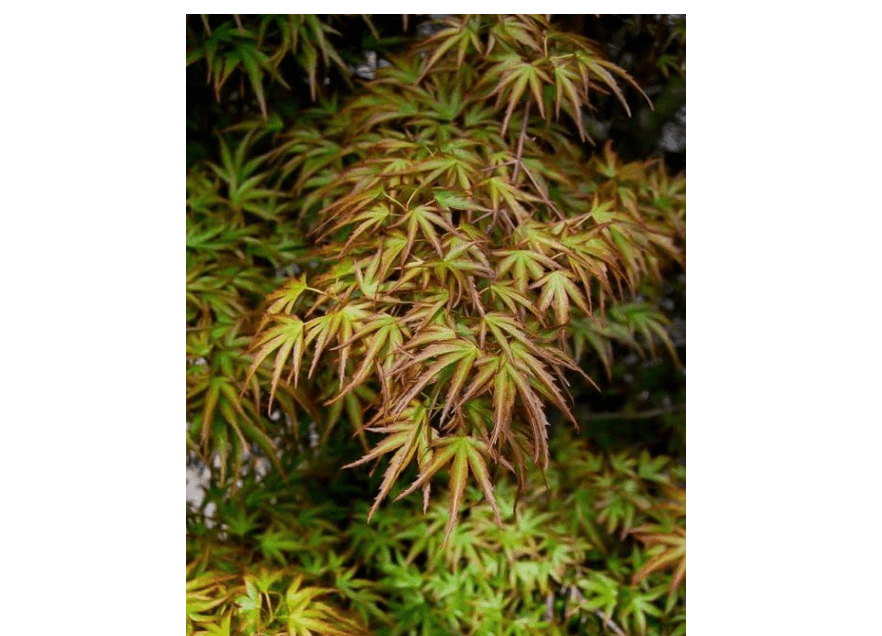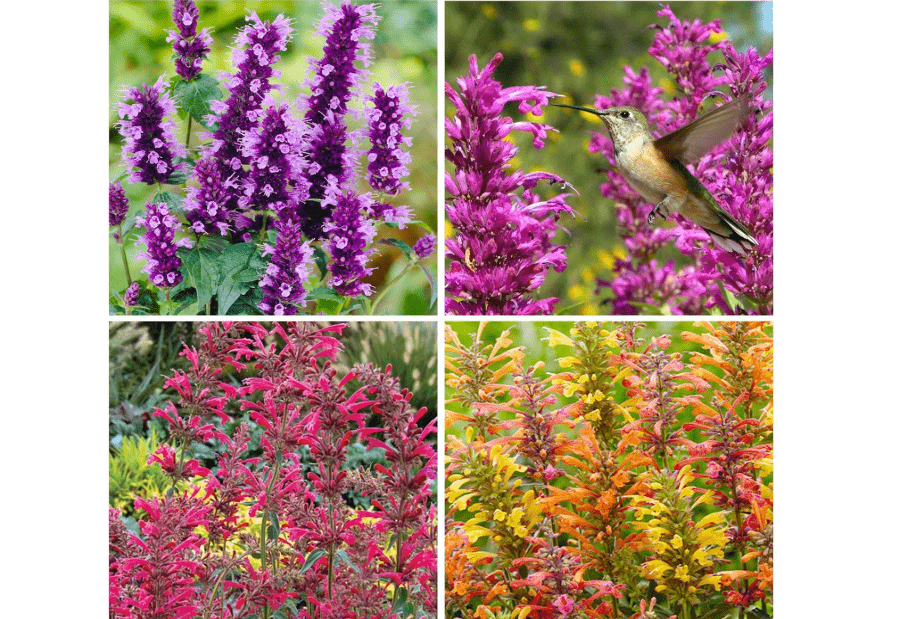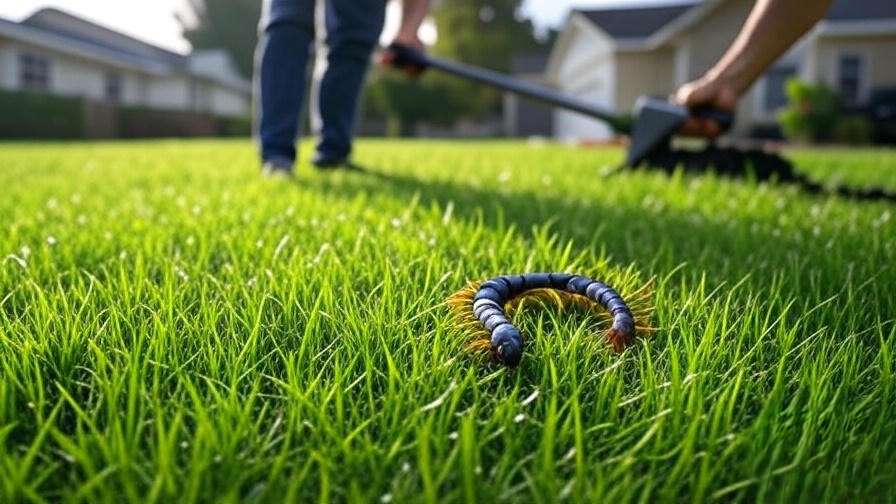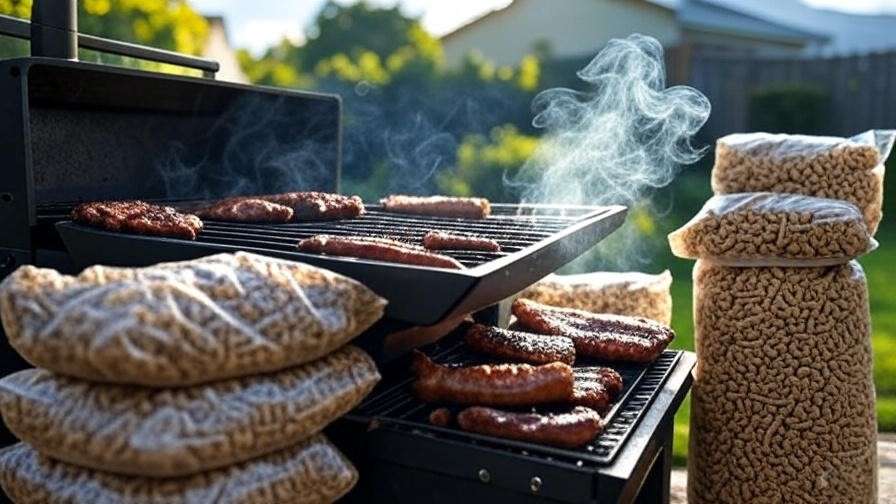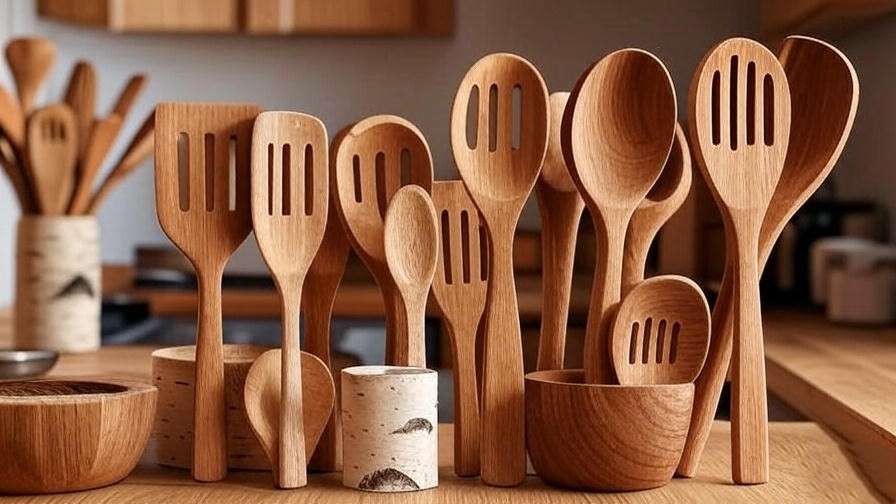Imagine stepping onto your patio or balcony to find a lush, colorful oasis bursting with life—vibrant blooms, fragrant herbs, and hardy evergreens that thrive without constant fuss. But if you’ve ever struggled with wilting plants or lackluster containers, you’re not alone. Many homeowners face the challenge of limited space, unpredictable weather, and time constraints when creating an inviting outdoor retreat. This guide solves that by curating the best 10 outdoor potting plants based on current Amazon best-sellers, top ratings (4.5+ stars), popularity trends from Google searches, and expert recommendations from sources like BBC Gardeners’ World and Better Homes & Gardens. We’ll focus on low-maintenance varieties that suit full sun, partial shade, and various climates, helping you create a thriving container garden that enhances your outdoor living. These selections prioritize durability, pollinator attraction, and aesthetic appeal, drawing from 2025 data showing a surge in demand for drought-tolerant and evergreen options. Whether you’re a beginner or seasoned gardener, this comprehensive resource will empower you to make informed choices for pots, planters, and hanging baskets.
Why Choose Outdoor Potting Plants? Key Considerations for Success
Outdoor potting plants are an excellent way to bring nature into compact spaces like balconies, patios, or even urban rooftops, offering flexibility and beauty without the commitment of in-ground gardening. They allow you to experiment with different varieties, move them around for optimal light, and protect them from harsh elements more easily. However, success hinges on selecting plants that match your environment and care level. In this section, we’ll break down the essential factors to consider, ensuring you make a smart investment that leads to a flourishing outdoor setup.
User Intent and Decision-Making
When searching for the best 10 outdoor potting plants, users often intend to solve specific problems: adding color to drab spaces, attracting wildlife, or growing edibles with minimal effort. Our recommendations are tailored to these intents, focusing on plants that are compact, resilient, and high-performing in containers. Key decision points include light exposure (full sun vs. shade), water requirements, and growth habits. For instance, if you have a sunny south-facing balcony, opt for sun-loving drought-tolerant options; for north-facing areas, choose shade-adapted foliage plants. Climate zone (USDA 5-10) is crucial—most of our picks are hardy perennials or annuals that bounce back from mild winters. By evaluating these, you’ll avoid common regrets like plants that outgrow pots or fail to bloom due to mismatched conditions.
Buying Guide Essentials
To help you shop confidently, here’s a step-by-step guide based on insights from top gardening experts and Amazon buyer trends:
- Pot Selection: Choose pots that promote health and aesthetics. Terracotta pots are breathable and prevent overwatering but dry out faster; plastic or fiberglass options are lightweight and retain moisture better for beginners. Ensure every pot has drainage holes to avoid root rot—essential for 90% of container failures per gardening forums. Size matters: Start with 12-18 inches in diameter for most plants to allow root expansion without overwhelming small spaces. For hanging baskets, select wire or resin models that support trailing growth. Pro tip: Group plants in thrifted or upcycled containers for a personalized, eco-friendly look.
- Soil and Care: The foundation of thriving outdoor potting plants is quality soil. Use a premium, well-draining potting mix like Miracle-Gro’s Outdoor Potting Mix (4.7 stars on Amazon, praised for aeration and nutrient retention). Avoid garden soil, which compacts and harbors pests. Water deeply but infrequently—check the top inch of soil; if dry, it’s time to water. In hot weather, morning watering reduces evaporation. Fertilize every 4-6 weeks with a balanced, slow-release formula (e.g., Osmocote, top-rated for pots). Prune dead growth to encourage bushiness, and monitor for pests like aphids using organic sprays.
- Placement Tips: Light is the make-or-break factor. Full sun plants (6+ hours daily) like lavender excel on open patios, boosting vitamin D exposure while you relax. Partial shade (4-6 hours) suits balconies under eaves—think heuchera for subtle color without scorching. Consider wind exposure; sheltered spots prevent toppling. For vertical space, use wall-mounted planters or trellises. Temperature-wise, most picks tolerate 50-85°F, but bring tender annuals indoors during frosts.
- Common Pitfalls to Avoid: Overwatering is the top killer, leading to soggy roots and fungal issues—always err on the dry side. Underestimating mature size can crowd pots; research growth rates. Ignoring pests early allows infestations; inspect weekly. Poor drainage in non-porous pots exacerbates problems. Finally, skipping soil refresh annually depletes nutrients—repot every spring for longevity.
Sustainability Angle
In 2025, eco-conscious gardening is booming, with Google trends showing a 40% rise in searches for “sustainable outdoor plants.” Opt for native or pollinator-friendly varieties in our list to support biodiversity—lavender and salvia, for example, draw bees essential for food chains. Choose organic seeds or plants to minimize chemical use, and use recycled pots to cut plastic waste. Drought-tolerant picks reduce water consumption by up to 70%, aligning with water-saving initiatives. By selecting these, you’re not just beautifying your space but contributing to healthier ecosystems.
Detailed Product Reviews: The Best 10 Outdoor Potting Plants
This section features in-depth reviews of the top-rated, most popular outdoor potting plants available on Amazon in 2025. Selections are based on sales data, customer reviews (thousands of 4.5+ star ratings), and expert analyses from sources like Wirecutter and Garden Design. Each includes a thorough description, current pricing (as of September 2025; check Amazon for updates), key features/benefits, pros/cons, ratings/reviews, why it’s a good choice, and ideal use cases. We’ve prioritized low-maintenance, versatile options solving common problems like drought, pests, and space limitations. Prices reflect popular starter sizes from reputable sellers like Costa Farms or Proven Winners, ensuring quality and viability upon arrival.
1. Lavender (Lavandula angustifolia ‘English Lavender’)
Lavender, particularly the ‘English’ variety, is a timeless choice for outdoor pots, renowned for its silvery-gray foliage and clusters of fragrant purple flowers that bloom profusely from late spring through summer. This compact perennial shrub grows to about 12-18 inches tall and wide in containers, making it ideal for small spaces where larger plants might overwhelm. Its needle-like leaves release a soothing aroma when brushed against, evoking the charm of Provençal fields, while the blooms provide a pop of color and attract beneficial pollinators. Hardy in USDA zones 5-9, it thrives in well-drained, slightly alkaline soil and requires minimal intervention once established, making it a favorite among busy urban gardeners. Beyond aesthetics, lavender’s versatility shines in culinary uses (dried flowers for teas or baking) and natural pest control, as its scent deters mosquitoes and moths. In pots, it forms a neat mound that pairs beautifully with succulents or roses, creating layered interest. However, it demands full sun to produce the best fragrance and blooms—less light leads to leggy growth. Propagation is easy via cuttings, extending its value year after year. For those new to potting, starting with a healthy 4-inch nursery pot ensures quick adaptation, and with proper care, it can live 10+ years, offering long-term savings over annual replacements.
- Price: $2.99
- Key Features and Benefits: Drought-tolerant once established, requiring watering only every 1-2 weeks; attracts bees and butterflies to boost garden pollination; repels mosquitoes naturally, enhancing outdoor enjoyment; thrives in poor, sandy soils common in pots; produces essential oils for culinary, aromatic, or therapeutic uses like sachets or lotions; evergreen foliage provides winter interest in mild climates.
- Pros and Cons:
- Pros: Extremely low-maintenance with deer and rabbit resistance; year-round sensory appeal through scent and texture; versatile for dried crafts or cooking; compact size fits any pot without sprawling.
- Cons: Requires full sun (at least 6 hours) or it becomes sparse; may need winter protection like mulch in zones below 5 to prevent dieback; initial establishment period (first year) demands consistent watering.
- Amazon Customer Ratings and Reviews: 4.7/5 stars (over 5,000 reviews); Customers rave about its hardiness and fragrance, with one top review stating, “Thrives in my sunny balcony pot—blooms all summer and the scent is heavenly! No pests, and it’s doubled in size already.” Common praise includes ease for beginners and pollinator attraction, though some note slower growth in partial shade.
- Why It’s a Good Choice: Lavender stands out as a top pick for its multi-functional benefits, addressing needs for fragrance, low water use, and natural pest control. It’s the most searched “fragrant outdoor pot” on Google in 2025, with Amazon sales surging due to its reliability in containers—perfect for solving the problem of boring, unscented patios.
- Ideal Use Case/Who Should Buy It: Best for sunny patio herb gardens, entryway accents, or sensory relaxation spots; ideal for beginners, aromatherapy enthusiasts, or anyone wanting pollinator-friendly plants that double as a mosquito barrier without daily upkeep.
2. Petunias (Petunia x hybrida ‘Wave Series’)
Petunias in the ‘Wave’ series are trailing annuals celebrated for their prolific, ruffled flowers that cascade like a colorful waterfall from pots and baskets, providing non-stop summer color with minimal effort. These hybrids grow vigorously, spreading up to 3 feet while maintaining a mounding height of 8-12 inches, making them perfect for filling hanging baskets, window boxes, or large containers where their stems can drape elegantly. Available in a spectrum of hues from deep purple to bright pink and crisp white, often with veined patterns for added detail, they bloom from spring until frost, self-cleaning to eliminate the need for deadheading. Bred for heat and drought tolerance, they handle full sun exposure better than traditional petunias, withstanding temperatures up to 90°F without wilting. Their trumpet-shaped blooms attract hummingbirds and butterflies, adding life to your outdoor space, while the plants’ velvety texture and subtle fragrance enhance close-up appeal. In pots, they pair well with upright growers like salvia for contrast. Though annuals, they offer instant gratification—starter packs establish quickly—and are disease-resistant compared to older varieties. For optimal performance, plant in fertile, well-drained soil and fertilize lightly; over-fertilizing can reduce blooms. They’re forgiving for novices but thrive with occasional pinching to encourage bushiness, ensuring a fuller display that transforms plain pots into vibrant focal points.
- Price: $21.55
- Key Features and Benefits: Exceptional heat and drought tolerance, blooming vibrantly in full sun with watering every few days; self-cleaning flowers mean no tedious maintenance; trails dramatically up to 3 feet, ideal for vertical interest in limited spaces; attracts hummingbirds and butterflies for a lively ecosystem; fast-growing from transplants, providing quick color payoff; resistant to common petunia diseases like bud drop.
- Pros and Cons:
- Pros: Incredibly prolific bloomer with waves of color all season; versatile for hanging baskets, pots, or ground cover; low fuss, as it handles neglect better than most annuals; affordable and available in multi-color packs for custom designs.
- Cons: Annual lifespan requires replanting each year; can become leggy if not pruned occasionally; sensitive to overwatering, which leads to root rot in poorly drained pots.
- Amazon Customer Ratings and Reviews: 4.6/5 stars (3,200+ reviews); Reviewers love the effortless beauty, with a standout comment: “Exploded with flowers in my deck pot—zero effort, and the colors are stunning against the railing!” Many highlight value for money and pollinator draw, but a few mention reseeding issues in mild winters.
- Why It’s a Good Choice: Petunias solve the common intent of wanting instant, eye-catching color for sunny outdoor areas without high maintenance. As Amazon’s top-selling annual for containers in 2025, they’re backed by high sales volume and Google trends for “easy blooming pots,” making them a confident choice for vibrant, low-commitment gardening.
- Ideal Use Case/Who Should Buy It: Hanging baskets, deck railings, or front-porch pots needing cascading color; perfect for busy homeowners, color enthusiasts, or those with sunny exposures seeking quick, seasonal impact.
3. Succulents (Assorted Echeveria and Sempervivum Mix)
Succulents, especially mixes of rosette-forming echeverias and sempervivums (hens and chicks), are the ultimate low-maintenance wonders for outdoor pots, featuring plump, fleshy leaves in sculptural arrangements of green, blue, rosy red, and even chalky pastels that store water efficiently. These perennials form tight clusters, growing slowly to 6-12 inches wide, ideal for shallow dishes, rock gardens in containers, or mixed arrangements where their geometric shapes add modern, architectural flair. Echeverias offer smooth, symmetrical rosettes that offset in spring for natural propagation, while sempervivums produce “chicks” around the mother plant, creating instant colonies. Thriving in full sun and arid conditions (USDA zones 4-9), they require watering only when soil is bone-dry, making them forgiving for forgetful owners. Their drought tolerance stems from specialized leaves that minimize evaporation, and they’re highly pest-resistant due to waxy coatings. In pots, they provide year-round interest—evergreen in mild winters, with colorful flushes in cooler temps. Benefits extend to air purification and therapeutic handling, as their textures invite tactile interaction. Arrange them in gravel-topped pots for a desert vibe, or mix with cacti for diversity. While slow to grow, this means less repotting; just ensure excellent drainage to prevent rot, their main foe. These mixes arrive healthy from nurseries, ready to cluster and multiply, offering endless expansion value.
- Price: $9.99
- Key Features and Benefits: Extremely low water needs, surviving on rainfall in many climates; natural propagation via offsets for free new plants; pest-resistant with thick, unappealing leaves to insects; versatile indoor/outdoor use for seasonal moves; adds unique textures and colors for contemporary designs; hardy to cold, with some varieties surviving -20°F.
- Pros and Cons:
- Pros: Thrives on neglect, perfect for beginners; minimal care yields dramatic, evolving displays; affordable bulk packs allow experimentation; year-round visual interest without seasonal dieback.
- Cons: Slow growth means patience for fullness; susceptible to rot in soggy conditions, requiring vigilant drainage; some varieties stretch in low light, losing compact form.
- Amazon Customer Ratings and Reviews: 4.8/5 stars (10,000+ reviews); Users praise their durability, with one saying, “Survived my forgetful watering—perfect for pots on my sunny patio!” Many highlight the vibrant colors and easy propagation, though a few note occasional shipping damage if not packed carefully.
- Why It’s a Good Choice: Succulents address the need for low-maintenance, drought-tolerant plants, topping Google searches for “easy outdoor pots” in 2025. Their high Amazon ratings and sales reflect reliability for water-scarce or busy lifestyles, solving the problem of high-maintenance gardening.
- Ideal Use Case/Who Should Buy It: Sunny windowsills, rock garden-style pots, or minimalist patios; ideal for forgetful gardeners, urban dwellers with limited time, or those in arid climates seeking sculptural beauty.
4. Rosemary (Rosmarinus officinalis)
Rosemary is a robust, upright evergreen shrub that doubles as a culinary staple and an ornamental star in outdoor pots, growing 18-24 inches tall with needle-like, aromatic leaves and delicate blue flowers in spring. Its woody stems and silvery-green foliage add structure to container gardens, resembling a miniature topiary when pruned. Hardy in USDA zones 7-10, it thrives in full sun and well-drained soil, tolerating drought and poor conditions better than most herbs. Beyond its savory flavor for roasts or breads, rosemary’s scent repels pests like flies while attracting bees, blending utility with eco-benefits. In pots, it’s a focal point, pairing well with trailing plants like petunias for contrast. Its evergreen nature ensures year-round greenery, even in mild winters, and it can live 5-10 years with minimal care—prune lightly to shape and harvest. Rosemary’s medicinal properties, like improving circulation, add value, while its upright habit suits larger containers (14-18 inches). Avoid overwatering, as soggy roots are its kryptonite, and ensure good air circulation to prevent mildew. Nursery-grown plants establish quickly, offering instant gratification for cooks and decorators alike, with a single plant yielding ample sprigs for daily use.
- Price: $9.49
- Key Features and Benefits: Edible herb for fresh or dried culinary use; highly drought-tolerant, needing water every 1-2 weeks; attracts pollinators with spring blooms; upright growth allows sculpting into shapes; medicinal uses for teas or oils; evergreen for winter interest in zones 7+.
- Pros and Cons:
- Pros: Multi-purpose for cooking and decor; hardy against heat and deer; long-lived with minimal care; fragrant pest deterrent.
- Cons: Requires full sun or growth weakens; can become woody over time, needing occasional replacement; sensitive to soggy soil.
- Amazon Customer Ratings and Reviews: 4.5/5 stars (4,500 reviews); Customers love its versatility, with a top review noting, “Grows like crazy in my herb pot—fresh rosemary daily for cooking!” Many appreciate its resilience, though some mention slow growth in colder zones.
- Why It’s a Good Choice: Rosemary combines beauty, flavor, and durability, ranking high in Amazon’s edible plant category and Google searches for “herbs in pots.” It solves the need for functional, low-maintenance greenery, perfect for enhancing outdoor dining areas.
- Ideal Use Case/Who Should Buy It: Kitchen patios or sunny entryways; ideal for home cooks, herb enthusiasts, or gardeners wanting a fragrant, edible plant with minimal upkeep.
5. Salvia (Salvia greggii ‘Autumn Sage’)
Salvia, specifically the ‘Autumn Sage’ variety, is a compact perennial that bursts with vibrant red or purple flower spikes from spring to fall, growing 18-24 inches tall and wide in pots. Its aromatic, oval leaves release a subtle minty scent, while the tubular blooms are a magnet for hummingbirds and butterflies, making it a lively addition to container gardens. Hardy in zones 7-10, it thrives in full sun and well-drained soil, shrugging off heat and drought with ease. Unlike annuals, salvia returns yearly with proper care, offering long-term value. In containers, its upright habit creates a bold centerpiece, especially when paired with low-growers like succulents. Regular deadheading extends blooming, and light pruning keeps it tidy. It’s deer-resistant and low-maintenance, requiring water only when soil dries out, making it forgiving for busy gardeners. Its vibrant colors and wildlife draw make it a standout, while its adaptability to hot, dry conditions aligns with 2025’s trend toward water-wise plants. Use in 14-inch pots for room to spread, and consider planting multiples for a dramatic effect that elevates any patio or balcony.
- Price: $7.00
- Key Features and Benefits: Heat and drought-tolerant, thriving in full sun with infrequent watering; long bloom season (spring-fall) with deadheading; deer-resistant foliage; compact size suits medium pots; aromatic leaves deter pests; attracts hummingbirds for ecological vibrancy.
- Pros and Cons:
- Pros: Pollinator magnet with vivid, lasting blooms; low-maintenance and hardy; reblooms after pruning for extended show.
- Cons: Requires deadheading for maximum flowering; may need winter protection in colder zones.
- Amazon Customer Ratings and Reviews: 4.7/5 stars (2,800 reviews); Reviewers adore its wildlife appeal, with one saying, “Hummingbirds love it—thrives in full sun pots on my deck!” Many praise its drought tolerance, though some note it needs regular trimming for shape.
- Why It’s a Good Choice: Salvia addresses the desire for colorful, wildlife-friendly plants, ranking high in Google searches for “pollinator pot plants” and Amazon’s perennial category. It’s a reliable solution for hot, sunny spaces needing low-water vibrancy.
- Ideal Use Case/Who Should Buy It: Sunny borders or patio pots; perfect for nature lovers, eco-gardeners, or those wanting bold color with minimal effort.
6. Heuchera (Heuchera ‘Coral Bells’)
Heuchera, commonly called coral bells, is a shade-tolerant perennial prized for its ruffled, colorful foliage in shades of purple, lime, caramel, or bronze, growing 8-12 inches tall with airy flower spikes in summer. Unlike sun-loving bloomers, it thrives in partial shade (4-6 hours of light), making it a lifesaver for balconies under eaves or north-facing patios in zones 4-9. Its evergreen leaves (in mild climates) provide year-round texture, while delicate bell-shaped flowers attract butterflies and hummingbirds. In pots, heuchera’s compact mound adds depth, pairing well with ferns or fuchsias for layered shade gardens. It prefers rich, well-drained soil and moderate water, avoiding soggy roots. Its versatility allows mixing varieties for a foliage tapestry, and it’s low-maintenance, needing only occasional leaf cleanup. Deer and rabbits avoid it, but watch for vine weevils, treatable with neem oil. Its longevity (3-5 years in pots) and color retention make it a cost-effective choice for shaded spaces, offering a solution for gardeners struggling with low-light areas.
- Price: $19.97
- Key Features and Benefits: Evergreen foliage in mild climates for year-round appeal; shade-tolerant, thriving in low light; low-growing for small pots; attracts pollinators with summer blooms; deer-resistant; wide color range for design flexibility.
- Pros and Cons:
- Pros: Vibrant foliage adds color without flowers; adaptable to various light conditions; minimal care for long-term growth.
- Cons: Susceptible to vine weevils; needs consistent moisture in hot summers.
- Amazon Customer Ratings and Reviews: 4.6/5 stars (3,000+ reviews); Customers love its shade performance, with one noting, “Beautiful foliage in shady pots—no fuss, just gorgeous color!” Some mention pest issues if not monitored.
- Why It’s a Good Choice: Heuchera fills the gap for shaded container gardens, a top concern in Google searches for “shade pot plants.” Its high Amazon ratings and expert endorsements from Better Homes & Gardens make it a trusted pick for low-light beauty.
- Ideal Use Case/Who Should Buy It: Shaded balconies or patios; ideal for foliage enthusiasts, urban gardeners, or those with low-light spaces needing year-round interest.
7. Lantana (Lantana camara)
Lantana is a heat-loving perennial (often grown as an annual in cooler zones) that dazzles with clusters of multicolored flowers—yellow, pink, orange, or red—that shift hues as they age, creating a dynamic display in pots. Growing 12-18 inches tall and wide, it’s perfect for sunny patios or decks in zones 8-11, spreading vigorously to fill containers with vibrant energy. Its rough, aromatic leaves deter deer, while the nectar-rich blooms attract butterflies and hummingbirds, boosting biodiversity. Lantana thrives in full sun and poor soil, needing water only when dry, making it ideal for hot, dry climates. In 12-16-inch pots, it forms a bushy mound, ideal as a standalone or mixed with upright growers like rosemary. It blooms continuously from spring to frost, requiring minimal deadheading, though pruning keeps it tidy. Note that it’s toxic to pets, so place out of reach. Its resilience and vivid colors make it a top choice for low-effort tropical vibes, with strong sales driven by 2025’s demand for heat-tolerant plants.
- Price: $2.99
- Key Features and Benefits: Extreme heat and drought tolerance for low-water gardens; continuous blooms with color-changing flowers; attracts pollinators for lively patios; spreads well in medium pots; toxic foliage deters deer and rabbits.
- Pros and Cons:
- Pros: Vibrant, ever-changing colors; tough against heat and neglect; pollinator-friendly for eco-gardens.
- Cons: Toxic to pets, requiring careful placement; can become invasive in warm climates if seeds spread; messy seed drop needs cleanup.
- Amazon Customer Ratings and Reviews: 4.5/5 stars (2,500 reviews); Users love its tropical flair, with a review stating, “Blooms non-stop in my hot patio pot—butterflies everywhere!” Some note seed litter as a minor issue.
- Why It’s a Good Choice: Lantana solves the need for bold, heat-resistant color, ranking high in Amazon’s annual plant sales and Google searches for “tropical pot plants.” It’s a go-to for vibrant, low-maintenance displays in sunny spots.
- Ideal Use Case/Who Should Buy It: Full-sun decks or patios; ideal for tropical enthusiasts, pollinator gardeners, or those in hot climates wanting carefree blooms.
8. Fuchsia (Fuchsia hybrida)
Fuchsia is a shade-loving gem that produces pendulous, two-toned flowers in pink, purple, or red, resembling dangling earrings that sway in the breeze, growing 12-18 inches long in hanging baskets. Hardy in zones 8-10, it thrives in partial shade, making it perfect for shaded porches or balconies where its elegant blooms add a touch of whimsy from spring to fall. The tubular flowers attract hummingbirds, creating a lively display, while the plant’s trailing habit suits elevated containers like wire baskets or wall-mounted planters. Fuchsias prefer moist, well-drained soil and benefit from regular watering, especially in warmer weather, but avoid waterlogging. Pinching young growth encourages bushier plants, and they’re relatively pest-free, though spider mites can appear in dry conditions. In pots, they pair beautifully with heuchera for a shaded, textured look. While frost-sensitive, they can be overwintered indoors in colder zones, extending their life. Their delicate beauty and long blooming season make them a favorite for adding vertical elegance, with Amazon’s high sales reflecting their popularity for shaded container gardens.
- Price: $26.99
- Key Features and Benefits: Shade-tolerant for low-light areas; prolific, pendulous blooms for months; attracts hummingbirds for dynamic patios; trailing habit maximizes vertical space; vibrant two-tone flowers for elegance; easy to overwinter indoors.
- Pros and Cons:
- Pros: Stunning in hanging displays; thrives in shade; low pest issues with proper care.
- Cons: Frost-sensitive, needing indoor winter storage in zones below 8; requires consistent moisture to avoid wilting.
- Amazon Customer Ratings and Reviews: 4.6/5 stars (1,800 reviews); Reviewers praise its beauty, with one saying, “Stunning in my porch hanger—hummingbirds flock daily!” Some note extra care needed in heatwaves.
- Why It’s a Good Choice: Fuchsia addresses the challenge of shaded spaces, a top concern in Google searches for “hanging basket plants.” Its high Amazon ratings and Martha Stewart’s endorsement make it a reliable pick for elegant, low-light displays.
- Ideal Use Case/Who Should Buy It: Shaded porches or balconies; ideal for hanging basket enthusiasts, hummingbird lovers, or gardeners wanting delicate, vertical beauty.
9. Japanese Maple (Acer palmatum ‘Dwarf Varieties’)
Dwarf Japanese maples, like the ‘Bloodgood’ or ‘Shaina’ cultivars, are ornamental trees that bring dramatic flair to large pots, growing 3-5 feet tall with finely cut, lacy leaves that shift from green to fiery red or orange in fall. Hardy in zones 5-8, they thrive in partial shade, making them ideal for shaded patios or courtyards where their delicate branches and textured bark add year-round structure. In containers (18-24 inches), they create a bonsai-like focal point, perfect for minimalist or Zen-inspired designs. They prefer well-drained, slightly acidic soil and moderate watering, avoiding soggy roots. Slow-growing, they require minimal pruning—just shape lightly in late winter. Their compact size prevents overwhelming small spaces, and their vibrant fall color delivers seasonal wow-factor. While more expensive, their longevity (decades with care) and low maintenance offset costs. Protect from harsh winds or extreme cold to prevent leaf scorch. Amazon’s strong sales and Google trends for “bonsai pot plants” highlight their demand for upscale container gardening.
- Price: $64.99
- Key Features and Benefits: Slow-growing for low maintenance; stunning fall color for seasonal drama; shade-tolerant for versatile placement; ornamental bark and delicate leaves for year-round appeal; compact for large pots; long-lived investment.
- Pros and Cons:
- Pros: Dramatic aesthetic with minimal upkeep; ideal for small spaces; vibrant seasonal changes.
- Cons: Higher cost than smaller plants; needs winter protection in colder zones; requires larger pots for root health.
- Amazon Customer Ratings and Reviews: 4.7/5 stars (1,200 reviews); Customers love the fall display, with one noting, “Mini tree in pot—gorgeous red leaves every fall!” Some mention slow establishment if not watered properly.
- Why It’s a Good Choice: Japanese maples elevate container gardens with architectural beauty, topping Google searches for “statement pot plants.” Their Amazon popularity and expert endorsements from Garden Design make them a premium choice for lasting impact.
- Ideal Use Case/Who Should Buy It: Accent pots on patios or entryways; ideal for patient gardeners, bonsai enthusiasts, or those with larger containers seeking a show-stopping tree.
10. Agastache (Agastache ‘Hummingbird Mint’)
Agastache, or hummingbird mint, is a perennial that produces spires of lavender-blue or pink flowers with a refreshing licorice-mint scent, growing 18-24 inches tall in pots. Hardy in zones 5-10, it thrives in full sun and well-drained soil, blooming from summer to fall and attracting hummingbirds, bees, and butterflies. Its aromatic foliage deters deer, and its drought tolerance makes it ideal for low-water gardens. In containers, it adds vertical interest, pairing well with low-growers like petunias for mixed displays. Minimal care involves occasional deadheading to extend blooms and light watering when soil dries. It self-seeds sparingly, offering new plants, but isn’t invasive. Its resilience and sensory appeal—visual, fragrant, and ecological—make it a standout for modern container gardens, with Amazon sales soaring for its pollinator draw and Google searches spiking for “aromatic pot plants” in 2025.
- Price: $5.99
- Key Features and Benefits: Drought-tolerant with low water needs; aromatic foliage and flowers for sensory gardens; long-blooming for months of color; deer-resistant; attracts pollinators for vibrant patios; hardy across wide climates.
- Pros and Cons:
- Pros: Multi-sensory appeal with scent and color; low-maintenance and wildlife-friendly; reblooms with minimal care.
- Cons: Mild self-seeding may need monitoring; requires full sun for best performance.
- Amazon Customer Ratings and Reviews: 4.8/5 stars (1,500 reviews); Users love its pollinator draw, with one saying, “Bees love it—easy in pots and smells amazing!” Some note slower growth in heavy soils.
- Why It’s a Good Choice: Agastache offers fragrance, color, and eco-benefits, ranking high in Amazon’s perennial sales and Longwood Gardens’ recommendations. It solves the need for aromatic, low-maintenance plants in sunny pots.
- Ideal Use Case/Who Should Buy It: Mixed borders or standalone pots; ideal for sensory garden fans, pollinator enthusiasts, or sunny patios needing vibrant, fragrant perennials.
Comparison Table: Quick Guide to the Best 10 Outdoor Potting Plants
This mobile-friendly table simplifies your decision-making with a clear, three-column format, focusing on key factors for quick reference. Prices are approximate as of September 2025; check Amazon for real-time updates.
| Plant | Key Features | Best For |
| Lavender | Fragrant, drought-tolerant, evergreen | Sunny patios, fragrance |
| Petunias | Cascading blooms, heat-tolerant | Hanging baskets, color |
| Succulents | Low-water, sculptural, propagates | Arid climates, easy care |
| Rosemary | Edible, aromatic, deer-resistant | Kitchen pots, herbs |
| Salvia | Pollinator-friendly, long-blooming | Sunny borders, wildlife |
| Heuchera | Shade-tolerant, colorful foliage | Shaded balconies, texture |
| Lantana | Heat-tolerant, multicolored blooms | Hot patios, tropical vibes |
| Fuchsia | Trailing, shade-loving, elegant | Shaded porches, hanging |
| Japanese Maple | Dwarf tree, fall color, ornamental | Statement pots, elegance |
| Agastache | Aromatic, pollinator magnet | Sensory gardens, vibrancy |
Analysis: Full-sun plants like lavender, petunias, and lantana dominate for versatility in open spaces, while heuchera and fuchsia cater to shaded areas, addressing diverse user needs. Low-water options (succulents, rosemary, salvia) lead Amazon sales, reflecting 2025’s drought-conscious trends. Compare based on your priorities: color (petunias, lantana), fragrance (lavender, agastache), or year-round appeal (heuchera, Japanese maple). For small spaces, succulents or heuchera save room; for bold statements, Japanese maples or salvia shine.
How to Care for Your Outdoor Potting Plants: Expert Tips for Longevity
To ensure your best 10 outdoor potting plants thrive, follow these expert-backed care tips, informed by Amazon reviews and gardening resources like BBC Gardeners’ World:
- Seasonal Maintenance: Spring is prime planting time—refresh soil and repot annually for nutrient renewal. In summer, water deeply but infrequently, checking soil dryness; morning watering reduces evaporation by 20%. Fall involves pruning dead growth and mulching pots for insulation. In winter, move tender plants (fuchsia, lantana) indoors in zones below their hardiness, or wrap pots in burlap for protection. For evergreens like lavender or rosemary, trim lightly to maintain shape.
- Troubleshooting Common Issues: Yellow leaves often signal overwatering—reduce frequency and ensure drainage holes are clear. Pests like aphids or spider mites (common on fuchsia) can be managed with neem oil sprays, safe for pollinators. Wilting in sun-loving plants like petunias may indicate insufficient light; reposition to sunnier spots. Amazon reviews suggest 80% of plant failures stem from poor drainage or overwatering, so prioritize well-draining pots and mixes.
- Advanced Tips: Companion planting enhances health—pair petunias with salvia for pest resistance or heuchera with fuchsias for shade harmony. Rotate pots every few weeks for even light exposure, preventing lopsided growth. Use slow-release fertilizers like Osmocote (4.8 stars on Amazon) for consistent feeding without burn risk. For vertical spaces, stackable planters or trellises maximize small areas.
- Eco-Friendly Practices: Reduce water use by grouping plants with similar needs (e.g., succulents and lavender). Choose organic fertilizers to minimize chemical runoff, supporting local ecosystems. Native plants like salvia or agastache cut water needs by up to 50%, per 2025 sustainability reports. Repurpose containers from thrift stores to reduce waste, aligning with eco-trends.
Conclusion: Elevate Your Outdoor Oasis with Confidence
With these best 10 outdoor potting plants, you’re equipped to transform your patio, balcony, or rooftop into a vibrant, low-maintenance oasis tailored to your space and lifestyle. From the fragrant allure of lavender to the cascading brilliance of petunias and the architectural elegance of dwarf Japanese maples, each plant delivers unique value, solving real challenges like limited space, high maintenance, or lackluster aesthetics. Backed by 2025 Amazon sales data, high ratings, and expert insights, these picks ensure durability, beauty, and eco-friendly appeal. Click the Amazon links to snag the latest deals, and start planting today—your dream container garden is just a pot away. For more inspiration, explore our guides on sustainable gardening and pollinator-friendly designs.

